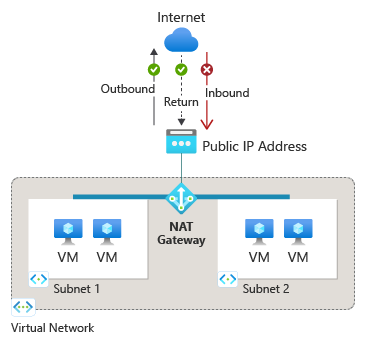What Is Azure NAT Gateway

In this article
Azure NAT Gateway is a fully managed and highly resilient Network Address Translation (NAT) service. You can use Azure NAT Gateway to let all instances in a private subnet connect outbound to the internet while remaining fully private. Unsolicited inbound connections from the internet aren't permitted through a NAT gateway. Only packets arriving as response packets to an outbound connection can pass through a NAT gateway.
NAT Gateway provides dynamic SNAT port functionality to automatically scale outbound connectivity and reduce the risk of SNAT port exhaustion.

Figure: Azure NAT Gateway
Azure NAT Gateway provides outbound connectivity for many Azure resources, including:
- Azure virtual machine (VM) instances in a private subnet
- Azure Kubernetes Services (AKS) clusters
- Azure Function Apps
- Azure Firewall subnet
- Azure App Services instances (web applications, REST APIs, and mobile backends) through virtual network integration
- Azure Databricks with secure cluster connectivity and a default VNet or with VNet injection.
Azure NAT Gateway benefits
Simple Setup
Deployments are intentionally made simple with NAT gateway. Attach NAT gateway to a subnet and public IP address and start connecting outbound to the internet right away. There's zero maintenance and routing configurations required. More public IPs or subnets can be added later without impact to your existing configuration.
NAT gateway deployment steps:
- Create a non-zonal or zonal NAT gateway.
- Assign a public IP address or public IP prefix.
- Configure virtual network subnet to use a NAT gateway
If necessary, modify TCP idle timeout (optional). Review timers before you change the default.
Security
NAT Gateway is built on the zero trust network security model and is secure by default. With NAT gateway, private instances within a subnet don't need public IP addresses to reach the internet. Private resources can reach external sources outside the virtual network by source network address translating (SNAT) to NAT gateway's static public IP addresses or prefixes. You can provide a contiguous set of IPs for outbound connectivity by using a public IP prefix. Destination firewall rules can be configured based on this predictable IP list.
Resiliency
Azure NAT Gateway is a fully managed and distributed service. It doesn't depend on individual compute instances such as VMs or a single physical gateway device. A NAT gateway always has multiple fault domains and can sustain multiple failures without service outage. Software defined networking makes a NAT gateway highly resilient.
Scalability
NAT gateway is scaled out from creation. There isn't a ramp up or scale-out operation required. Azure manages the operation of NAT gateway for you.
Attach NAT gateway to a subnet to provide outbound connectivity for all private resources in that subnet. All subnets in a virtual network can use the same NAT gateway resource. Outbound connectivity can be scaled out by assigning up to 16 public IP addresses or a /28 size public IP prefix to NAT gateway. When a NAT gateway is associated to a public IP prefix, it automatically scales to the number of IP addresses needed for outbound.
Performance
Azure NAT Gateway is a software defined networking service. Each NAT gateway can process up to 50 Gbps of data for both outbound and return traffic.
A NAT gateway doesn't affect the network bandwidth of your compute resources. Learn more about NAT gateway's performance.
Azure NAT Gateway basics
Outbound connectivity
-
NAT gateway is the recommended method for outbound connectivity.
- To migrate outbound access to a NAT gateway from default outbound access or load balancer outbound rules, see Migrate outbound access to Azure NAT Gateway.
-
Outbound connectivity with NAT gateway is defined at a per subnet level. NAT gateway replaces the default Internet destination of a subnet.
-
No traffic routing configurations are required to use NAT gateway.
-
NAT gateway allows flows to be created from the virtual network to the services outside your virtual network. Return traffic from the internet is only allowed in response to an active flow. Services outside your virtual network can’t initiate an inbound connection through NAT gateway.
-
NAT gateway takes precedence over other outbound connectivity methods, including Load balancer, instance-level public IP addresses, and Azure Firewall.
-
When NAT gateway is configured to a virtual network where a different outbound connectivity method already exists, NAT gateway takes over all outbound traffic moving forward. There are no drops in traffic flow for existing connections on Load balancer. All new connections use NAT gateway.
-
NAT gateway doesn't have the same limitations of SNAT port exhaustion as does default outbound access and outbound rules of a load balancer.
-
NAT gateway supports TCP and UDP protocols only. ICMP isn't supported.
Traffic routes
- NAT gateway replaces a subnet’s default route to the internet when configured. All traffic within the 0.0.0.0/0 prefix has a next hop type to NAT gateway before connecting outbound to the internet.
- You can override NAT gateway as a subnet’s next hop to the internet with the creation of a custom user-defined route (UDR).
- Presence of custom UDRs for virtual appliances and ExpressRoute override NAT gateway for directing internet bound traffic (route to the 0.0.0.0/0 address prefix).
- Outbound connectivity follows this order of precedence among different routing and outbound connectivity methods: Virtual appliance UDR / ExpressRoute >> NAT gateway >> Instance-level public IP address on a virtual machine >> Load balancer outbound rules >> default system route to the internet
NAT gateway configurations
-
Multiple subnets within the same virtual network can either use different NAT gateways or the same NAT gateway.
-
Multiple NAT gateways can’t be attached to a single subnet.
-
A NAT gateway can’t span multiple virtual networks.
-
A NAT gateway can’t be deployed in a gateway subnet.
-
A NAT gateway resource can use up to 16 IP addresses in any combination of:
- Public IP addresses
- Public IP prefixes
- Public IP addresses and prefixes derived from custom IP prefixes (BYOIP), to learn more, see Custom IP address prefix (BYOIP).
-
NAT gateway can’t be associated to an IPv6 public IP address or IPv6 public IP prefix.
-
NAT gateway can be used with Load balancer using outbound rules to provide dual-stack outbound connectivity, see dual stack outbound connectivity with NAT gateway and Load balancer.
-
NAT gateway works with any virtual machine network interface or IP configuration. NAT gateway can SNAT multiple IP configurations on a NIC.
-
NAT gateway can be associated to an Azure Firewall subnet in a hub virtual network and provide outbound connectivity from spoke virtual networks peered to the hub. To learn more, see Azure Firewall integration with NAT gateway.
Availability zones
- A NAT gateway can be created in a specific availability zone or placed in 'no zone'.
- NAT gateway can be isolated in a specific zone when you create zone isolation scenarios. This deployment is called a zonal deployment. After NAT gateway is deployed, the zone selection can't be changed.
- NAT gateway is placed in 'no zone' by default. A non-zonal NAT gateway is placed in a zone for you by Azure.
NAT gateway and basic SKU resources
-
NAT gateway is compatible with standard SKU public IP addresses or public IP prefix resources or a combination of both.
-
Basic SKU resources, such as basic load balancer or basic public IPs aren't compatible with NAT gateway. NAT gateway can't be used with subnets where basic SKU resources exist. Basic load balancer and basic public IP can be upgraded to standard to work with a NAT gateway
- Upgrade a load balancer from basic to standard, see Upgrade a public basic Azure Load Balancer.
- Upgrade a public IP from basic to standard, see Upgrade a public IP address.
- Upgrade a basic public IP attached to a VM from basic to standard, see Upgrade a basic public IP attached to a VM.
Connection timeouts and timers
- NAT gateway sends a TCP Reset (RST) packet for any connection flow that it doesn't recognize as an existing connection. The connection flow may no longer exist if the NAT gateway idle timeout was reached or the connection was closed earlier.
- When the sender of traffic on the nonexisting connection flow receives the NAT gateway TCP RST packet, the connection is no longer usable.
- SNAT ports aren't readily available for reuse to the same destination endpoint after a connection closes. NAT gateway places SNAT ports in a cool down state before they can be reused to connect to the same destination endpoint.
- SNAT port reuse (cool down) timer durations vary for TCP traffic depending on how the connection closes. To learn more, see Port Reuse Timers.
- A default TCP idle timeout of 4 minutes is used and can be increased to up to 120 minutes. Any activity on a flow can also reset the idle timer, including TCP keepalives. To learn more, see Idle Timeout Timers.
- UDP traffic has an idle timeout timer of 4 minutes that can't be changed.
- UDP traffic has a port reuse timer of 65 seconds for which a port is in hold down before it's available for reuse to the same destination endpoint.
Pricing and SLA
For Azure NAT Gateway pricing, see NAT gateway pricing.
For information on the SLA, see SLA for Azure NAT Gateway.
Next steps
- To create and validate a NAT gateway, see Quickstart: Create a NAT gateway using the Azure portal.
- To view a video on more information about Azure NAT Gateway, see How to get better outbound connectivity using an Azure NAT gateway.
- Learn about the NAT gateway resource.
- Learn module: Introduction to Azure NAT Gateway.
- To learn more about architecture options for Azure NAT Gateway, see Azure Well-Architected Framework review of an Azure NAT gateway.